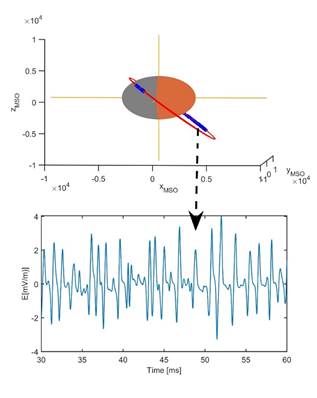Ministry of Science & Technology
First evidence of solitary waves near Mars may decode the mystery behind ion loss in the planet
प्रविष्टि तिथि:
16 JAN 2023 4:41PM by PIB Delhi
Scientists have reported the first evidence of the presence of solitary waves or distinct electric field fluctuations in the Martian magnetosphere. The study of these waves is crucial as they directly control particle energization, plasma loss, transport, etc., through wave-particle interactions.
Our Earth is a giant magnet, and its magnetic field protects us from high-speed charged particles that are continuously emitted from the Sun in the form of solar wind. Unlike Earth, the planet Mars do not have any intrinsic magnetic field. This allows the high-speed solar wind to interact directly with the Mars atmosphere, like an obstacle in flow. It has been suggested that even in a weak and thin magnetosphere as that of the Mars, one can observe frequent occurrences of solitary waves. However, despite several missions to Mars, the presence of solitary waves in the Martian magnetosphere has never been reported earlier.
For the first time, a research team from the Indian Institute of Geomagnetism (IIG), an autonomous institute of the Department of Science and Technology (DST), has identified and reported the solitary waves in the Martian magnetosphere with the help of high-resolution electric field data recorded by Langmuir Probe and Waves instrument on the Mars Atmosphere and Volatile EvolutioN (MAVEN) spacecraft of NASA (https://pds-ppi.igpp.ucla.edu). The magnetosphere is weak but highly dynamic and formed due to the direct interaction of solar winds with the Martian atmosphere.
Solitary waves are the distinct electric field fluctuations (bipolar or monopolar) that follow constant amplitude-phase relations. Their shape and size are less affected during their propagation. The magnitude and duration of these pulses are found to be 1-25 milivolt/meter and 0.2–1.7 milliseconds, respectively. These pulses are dominantly seen in the dawn and afternoon-dusk sectors at an altitude of 1000–3500 km around the Mars. The dominant occurrence of solitary waves in the dawn and dusk sector is still a mystery and needs further investigation. Through simulations, it is found that the spatial extent of these structures is very small (30-330 meters). As these waves are known to be responsible for the plasma energization and its transport in Earth’s magnetosphere, the team is further exploring their role in the particle dynamics in the Martian magnetosphere and whether such waves play any role in the loss of atmospheric ions on the Mars.
Publication link: DOI 10.3847/1538-4357/ac7b8b
For more details, please contact Dr. Bharati Kakad email: bharati.kakad@iigm.res.in, phone: +91-22-27484203.

Figure 1: Upper panel shows orbit of MAVEN spacecraft around planet Mars with occurrence if solitary waves in blue stars. The lower panel shows series of solitary wave structures seen in Martian atmosphere on February 9, 2015.
<><><><><>
SNC/RR
(रिलीज़ आईडी: 1891584)
आगंतुक पटल : 2903
इस विज्ञप्ति को इन भाषाओं में पढ़ें:
हिन्दी